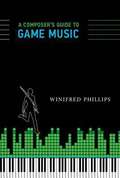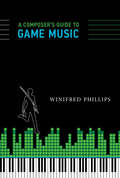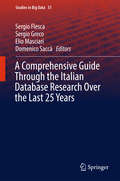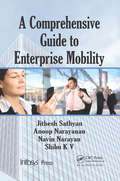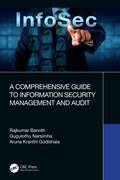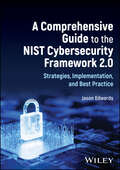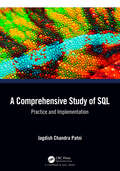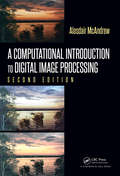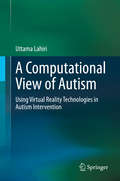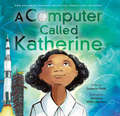- Table View
- List View
A Complete Guide to Docker for Operations and Development: Test-Prep for the Docker Certified Associate (DCA) Exam
by Engy FoudaHarness the power of Docker by containerizing your code with all its libraries and file systems to consistently run anywhere. This book is your source for learning all about Docker operations and development. It’s divided into two units and focuses on the topics that the Docker Certified Associate exam covers. Unit 1 covers the Docker fundamentals, such as Docker Enterprise for Operations, Docker Enterprise for Developers, Swarm, and an introduction to Kubernetes. You will learn how to install Docker Community Edition, Docker Enterprise Edition with Kubernetes and CLI. Also, you will learn the Docker cycle, container lifecycle, develop applications in any language, wrap, build, ship, and deploy them for production. Finally, you will learn how to create a Swarm cluster, deploy an app to it, and manage it with the best practices according to the current technologies. Unit 2 provides quizzes to help you prepare for the certification test. The DCA exam format and the question style has changed since Mirantis acquired Docker. To accommodate this, the quizzes mirror these changes. What You’ll Learn Understand the difference between containerization and virtualization Install Docker CE on various platforms and manage the resources Write Dockerfile, Docker Compose YAML, and Kubernetes manifest YAML files Compare microservices and monolithic applications Containerize monolithic applications Who This Book Is For Software developers, Cloud Architects, and DevOps operation managers.
A Complete Guide to Portals and User Experience Platforms
by Shailesh Kumar ShivakumarBuild a Next-Generation Enterprise Digital Platform with Portals and UXPA Complete Guide to Portals and User Experience Platforms provides in-depth coverage of portal technologies and user experience platforms (UXPs), which form the key pillars of a modern digital platform. Drawing on his experience in various roles in numerous portal engagements,
A Composer's Guide to Game Music
by Winifred PhillipsMusic in video games is often a sophisticated, complex composition that serves toengage the player, set the pace of play, and aid interactivity. Composers of video game music mustmaster an array of specialized skills not taught in the conservatory, including the creation oflinear loops, music chunks for horizontal resequencing, and compositional fragments for use within agenerative framework. In A Composer's Guide to Game Music, Winifred Phillips --herself an award-winning composer of video game music -- provides a comprehensive, practical guidethat leads an aspiring video game composer from acquiring the necessary creative skills tounderstanding the function of music in games to finding work in the field. Musicians and composersmay be drawn to game music composition because the game industry is a multibillion-dollar,employment-generating economic powerhouse, but, Phillips writes, the most important qualificationfor a musician who wants to become a game music composer is a love of video games. Phillips offersdetailed coverage of essential topics, including musicianship and composition experience; immersion;musical themes; music and game genres; workflow; working with a development team; linear music;interactive music, both rendered and generative; audio technology, from mixers and preamps tosoftware; and running a business. A Composer's Guide to Game Music offersindispensable guidance for musicians and composers who want to deploy their creativity in a dynamicand growing industry, protect their musical identities while working in a highly technical field,and create great music within the constraints of a new medium.
A Composer's Guide to Game Music (The\mit Press Ser.)
by Winifred PhillipsA comprehensive, practical guide to composing video game music, from acquiring the necessary skills to finding work in the field.Music in video games is often a sophisticated, complex composition that serves to engage the player, set the pace of play, and aid interactivity. Composers of video game music must master an array of specialized skills not taught in the conservatory, including the creation of linear loops, music chunks for horizontal resequencing, and compositional fragments for use within a generative framework. In A Composer's Guide to Game Music, Winifred Phillips—herself an award-winning composer of video game music—provides a comprehensive, practical guide that leads an aspiring video game composer from acquiring the necessary creative skills to understanding the function of music in games to finding work in the field.Musicians and composers may be drawn to game music composition because the game industry is a multibillion-dollar, employment-generating economic powerhouse, but, Phillips writes, the most important qualification for a musician who wants to become a game music composer is a love of video games. Phillips offers detailed coverage of essential topics, including musicianship and composition experience; immersion; musical themes; music and game genres; workflow; working with a development team; linear music; interactive music, both rendered and generative; audio technology, from mixers and preamps to software; and running a business.A Composer's Guide to Game Music offers indispensable guidance for musicians and composers who want to deploy their creativity in a dynamic and growing industry, protect their musical identities while working in a highly technical field, and create great music within the constraints of a new medium.
A Comprehensive Approach to Digital Manufacturing (Synthesis Lectures on Mechanical Engineering)
by Arif Sirinterlikci Yalcin ErtekinThis book draws a comprehensive approach to digital manufacturing through computer-aided design (CAD) and reverse engineering content complemented by basic CNC machining and computer-aided manufacturing (CAM), 3D printing, and additive manufacturing (AM) knowledge. The reader is exposed to a variety of subjects including the history, development, and future of digital manufacturing, a comprehensive look at 3D printing and AM, a comparative study between 3D printing and AM and CNC machining, and computer-aided engineering (CAE) along with 3D scanning. Applications of 3D printing and AM are presented as well as multiple special topics including design for 3D printing and AM (DfAM), costing, sustainability, environmental, safety, and health (EHS) issues. Contemporary subjects such as bio-printing, intellectual property (IP) and engineering ethics, virtual prototyping including augmented, virtual, and mixed reality (AR/VR/MR), and industrial Internet of Things (IIoT) are also covered.Each chapter comes with in-practice exercises and end-of-chapter questions, which can be used as home-works as well as hands-on or software-based laboratory activities. End-of-chapter questions are of three types mainly: review questions which can be answered by reviewing each chapter, research questions which need to be answered by conducting literature reviews and additional research, and discussion questions. In addition, some of the chapters include relevant problems or challenges which may require additional hands-on efforts. Most of the hands-on and practical content is driven by the authors’ previous experiences. The authors also encourage readers to help improve this book and its exercises by contacting them.
A Comprehensive Guide Through the Italian Database Research Over the Last 25 Years (Studies in Big Data #31)
by Elio Masciari Sergio Flesca Sergio Greco Domenico SaccàThis book offers readers a comprehensive guide to the evolution of the database field from its earliest stages up to the present--and from classical relational database management systems to the current Big Data metaphor. In particular, it gathers the most significant research from the Italian database community that had relevant intersections with international projects. Big Data technology is currently dominating both the market and research. The book provides readers with a broad overview of key research efforts in modelling, querying and analysing data, which, over the last few decades, have became massive and heterogeneous areas.
A Comprehensive Guide for Web3 Security: From Technology, Economic and Legal Aspects (Future of Business and Finance)
by Winston Ma Ken Huang Dyma Budorin Lisa Jy Tan Zhijun William ZhangWith the recent debacle of cryptocurrency exchange FTX and the crypto trading company Alameda Research, the importance of comprehending the security and regulations of Web3, cryptocurrency, and blockchain projects has been magnified. To avoid similar economic and security failures in future Web3 projects, the book provides an essential guide that offers a comprehensive and systematic approach to addressing security concerns. Written by experts in tech and finance, it provides an objective, professional, and in-depth analysis of security and privacy issues associated with Web3 and blockchain projects.This book highlights the security related to foundational Web3 building blocks such as blockchain, crypto wallets, smart contracts, and token economics, and describes recommended security processes and procedures for Web3 application development such as DevSecOps, data analytics, and data authenticity via the oracle. Moreover, the book discusses the legal and regulatory aspects of Web3 and the reasons behind the failures of well-known Web3 projects. It also contains detailed case studies of web3 projects, analyses of the reasons for their failures, and some pending legal cases.This book is an excellent resource for a diverse range of readers, with particular appeal to web3 developers, architects, project owners, and cybersecurity professionals seeking to deepen their knowledge of Web3 security.
A Comprehensive Guide to Enterprise Mobility
by Jithesh Sathyan Anoop N. Navin Narayan Shibu Kizhakke VallathaiAlthough enterprise mobility is in high demand across domains, an absence of experts who have worked on enterprise mobility has resulted in a lack of books on the subject. A Comprehensive Guide to Enterprise Mobility fills this void. It supplies authoritative guidance on all aspects of enterprise mobility-from technical aspects and applications to
A Comprehensive Guide to Information Security Management and Audit
by Rajkumar Banoth Gugulothu Narsimha Aruna Kranthi GodishalaThe text is written to provide readers with a comprehensive study of information security and management system, audit planning and preparation, audit techniques and collecting evidence, international information security (ISO) standard 27001, and asset management. It further discusses important topics such as security mechanisms, security standards, audit principles, audit competence and evaluation methods, and the principles of asset management. It will serve as an ideal reference text for senior undergraduate, graduate students, and researchers in fields including electrical engineering, electronics and communications engineering, computer engineering, and information technology. The book explores information security concepts and applications from an organizational information perspective and explains the process of audit planning and preparation. It further demonstrates audit techniques and collecting evidence to write important documentation by following the ISO 27001 standards. The book: Elaborates on the application of confidentiality, integrity, and availability (CIA) in the area of audit planning and preparation Covers topics such as managing business assets, agreements on how to deal with business assets, and media handling Demonstrates audit techniques and collects evidence to write the important documentation by following the ISO 27001 standards Explains how the organization’s assets are managed by asset management, and access control policies Presents seven case studies
A Comprehensive Guide to the NIST Cybersecurity Framework 2.0: Strategies, Implementation, and Best Practice
by Jason EdwardsLearn to enhance your organization’s cybersecurit y through the NIST Cybersecurit y Framework in this invaluable and accessible guide The National Institute of Standards and Technology (NIST) Cybersecurity Framework, produced in response to a 2014 US Presidential directive, has proven essential in standardizing approaches to cybersecurity risk and producing an efficient, adaptable toolkit for meeting cyber threats. As these threats have multiplied and escalated in recent years, this framework has evolved to meet new needs and reflect new best practices, and now has an international footprint. There has never been a greater need for cybersecurity professionals to understand this framework, its applications, and its potential. A Comprehensive Guide to the NIST Cybersecurity Framework 2.0 offers a vital introduction to this NIST framework and its implementation. Highlighting significant updates from the first version of the NIST framework, it works through each of the framework’s functions in turn, in language both beginners and experienced professionals can grasp. Replete with compliance and implementation strategies, it proves indispensable for the next generation of cybersecurity professionals. A Comprehensive Guide to the NIST Cybersecurity Framework 2.0 readers will also find: Clear, jargon-free language for both beginning and advanced readers Detailed discussion of all NIST framework components, including Govern, Identify, Protect, Detect, Respond, and Recover Hundreds of actionable recommendations for immediate implementation by cybersecurity professionals at all levels A Comprehensive Guide to the NIST Cybersecurity Framework 2.0 is ideal for cybersecurity professionals, business leaders and executives, IT consultants and advisors, and students and academics focused on the study of cybersecurity, information technology, or related fields.
A Comprehensive Study of SQL: Practice and Implementation
by Jagdish Chandra PatniA Comprehensive Study of SQL - Practice and Implementation is designed as a textbook and provides a comprehensive approach to SQL (Structured Query Language), the standard programming language for defining, organizing, and exploring data in relational databases. It demonstrates how to leverage the two most vital tools for data query and analysis – SQL and Excel – to perform comprehensive data analysis without the need for a sophisticated and expensive data mining tool or application. Features •The book provides a complete collection of modeling techniques, beginning with fundamentals and gradually progressing through increasingly complex real-world case studies. •It explains how to build, populate, and administer high-performance databases and develop robust SQL-based applications. •It also gives a solid foundation in best practices and relational theory. •The book offers self-contained lessons on key SQL concepts or techniques at the end of each chapter using numerous illustrations and annotated examples. This book is aimed primarily at advanced undergraduates and graduates with a background in computer science and information technology. Researchers and professionals will also find this book useful.
A Computational Introduction To Digital Image Processing, Second Edition
by Alasdair McandrewHighly Regarded, Accessible Approach to Image Processing Using Open-Source and Commercial Software A Computational Introduction to Digital Image Processing, Second Editionexplores the nature and use of digital images and shows how they can be obtained, stored, and displayed. Taking a strictly elementary perspective, the book only covers topics that involve simple mathematics yet offer a very broad and deep introduction to the discipline. New to the Second Edition This second edition provides users with three different computing options. Along with MATLAB®, this edition now includes GNU Octave and Python. Users can choose the best software to fit their needs or migrate from one system to another. Programs are written as modular as possible, allowing for greater flexibility, code reuse, and conciseness. This edition also contains new images, redrawn diagrams, and new discussions of edge-preserving blurring filters, ISODATA thresholding, Radon transform, corner detection, retinex algorithm, LZW compression, and other topics. Principles, Practices, and Programming Based on the author's successful image processing courses, this bestseller is suitable for classroom use or self-study. In a straightforward way, the text illustrates how to implement imaging techniques in MATLAB, GNU Octave, and Python. It includes numerous examples and exercises to give students hands-on practice with the material.
A Computational Introduction to Digital Image Processing
by Alasdair McAndrewHighly Regarded, Accessible Approach to Image Processing Using Open-Source and Commercial SoftwareA Computational Introduction to Digital Image Processing, Second Edition explores the nature and use of digital images and shows how they can be obtained, stored, and displayed. Taking a strictly elementary perspective, the book only covers topics that
A Computational View of Autism: Using Virtual Reality Technologies in Autism Intervention
by Uttama LahiriThis book first explains autism, its prevalence, and some conventional intervention techniques, and it then describes how virtual reality technology can support autism intervention and skills training. The approaches and technologies covered include immersive virtual reality, augmented reality and mixed reality. The tasks covered include emotion recognition, affective computing, teaching communication skills, imparting literacy skills, training for imitation skills, and joint attention skills. Most of the chapters assume no prerequisite knowledge of autism or virtual reality, and they are supported throughout with detailed references for further investigation.While the author is an engineer by profession, with specialist knowledge in robotics and computer-based platforms, in this book she adopts a user perspective and cites many real-life examples from her own experience. The book is suitable for students of cognitive science, and researchers and practitioners engaged with designing and offering technological assistance for special needs training.
A Computer Called Katherine: How Katherine Johnson Helped Put America on the Moon
by Suzanne SladeThe inspiring true story of mathematician Katherine Johnson--made famous by the award-winning film Hidden Figures--who counted and computed her way to NASA and helped put a man on the moon!Katherine knew it was wrong that African Americans didn't have the same rights as others--as wrong as 5+5=12. She knew it was wrong that people thought women could only be teachers or nurses--as wrong as 10-5=3. And she proved everyone wrong by zooming ahead of her classmates, starting college at fifteen, and eventually joining NASA, where her calculations helped pioneer America's first manned flight into space, its first manned orbit of Earth, and the world's first trip to the moon!Award-winning author Suzanne Slade and debut artist Veronica Miller Jamison tell the story of a NASA "computer" in this smartly written, charmingly illustrated biography.
A Computer Scientist's Guide to Cell Biology
by William W. Cohen Charles K. CohenUnlike the structured world of computer science, biology is complex, evolving, and often lacks clean abstract models. This book aims to serve as a guide for computer scientists who need to understand cell biology, breaking the field into three parts: biological mechanics, experimental methods, and language/nomenclature. While biological mechanics, which investigates cellular-level details, is covered by many texts, this book also focuses on experimental methods – how biologists conduct experiments and gather data - and on helping the reader understand the language and terminology of biology, which is rich but challenging for non-biologists. A Computer Scientist's Guide to Cell Biology uses a metaphor of biology as a strange land with an unfamiliar language and customs. The goal of the book is to provide a high-level introduction to cell biology, simplifying concepts and relating them to familiar ideas from computer science, so that working computer scientists can more effectively understand read recent research papers and results.This Second Edition contains a number of updates, including discussions of CRISPR, advances in DNA Sequencing, and mRNA vaccines. It serves as an easy-to-read travel guide for computer scientists navigating the intricate and sometimes perplexing terrain of cell biology, offering insights into experimental methods and helping bridge the gap between the structured world of computer science and the complexities of biological systems.
A Conceptual Guide to Statistics Using SPSS
by Steven P. Reise Elliot T. BerkmanBridging an understanding of Statistics and SPSS.This unique text helps students develop a conceptual understanding of a variety of statistical tests by linking the ideas learned in a statistics class from a traditional statistics textbook with the computational steps and output from SPSS. Each chapter begins with a student-friendly explanation of the concept behind each statistical test and how the test relates to that concept. The authors then walk through the steps to compute the test in SPSS and the output, clearly linking how the SPSS procedure and output connect back to the conceptual underpinnings of the test. By drawing clear connections between the theoretical and computational aspects of statistics, this engaging text aids students' understanding of theoretical concepts by teaching them in a practical context.
A Concise Handbook of Business Research: Special Emphasis on Data Analysis Using MS-Excel and R
by Vishnu Nath Ashish Arya Pankaj MadanThis book deals with the basics of Research Methodology (RM) for Business Research and statistical analysis for dealing with data using two software: R (a free statistical analysis environment) and MS-Excel. Apart from the basic concepts of Research Methodology, the book contains an additional chapter on improving academic writing. It contains important details on plagiarism, citation and referencing in MS-Word, and improving project/dissertation writing using free online software. Print edition not for sale in South Asia (India, Sri Lanka, Nepal, Bangladesh, Pakistan or Bhutan)
A Concise Introduction to Data Structures using Java (Chapman And Hall/crc Textbooks In Computing Ser. #11)
by Mark J. JohnsonA student-friendly text, A Concise Introduction to Data Structures Using Java takes a developmental approach, starting with simpler concepts first and then building toward greater complexity. Important topics, such as linked lists, are introduced gradually and revisited with increasing depth. More code and guidance are provided at the beginning, al
A Concise Introduction to Hypercomplex Fractals
by Andrzej KatuninThis book presents concisely the full story on complex and hypercomplex fractals, starting from the very first steps in complex dynamics and resulting complex fractal sets, through the generalizations of Julia and Mandelbrot sets on a complex plane and the Holy Grail of the fractal geometry – a 3D Mandelbrot set, and ending with hypercomplex, multicomplex and multihypercomplex fractal sets which are still under consideration of scientists. I tried to write this book in a possibly simple way in order to make it understandable to most people whose math knowledge covers the fundamentals of complex numbers only. Moreover, the book is full of illustrations of generated fractals and stories concerned with great mathematicians, number spaces and related fractals. In the most cases only information required for proper understanding of a nature of a given vector space or a construction of a given fractal set is provided, nevertheless a more advanced reader may treat this book as a fundamental compendium on hypercomplex fractals with references to purely scientific issues like dynamics and stability of hypercomplex systems.
A Concise Introduction to Image Processing using C++ (Chapman & Hall/CRC Numerical Analysis and Scientific Computing Series)
by Meiqing Wang Choi-Hong LaiImage recognition has become an increasingly dynamic field with new and emerging civil and military applications in security, exploration, and robotics. Written by experts in fractal-based image and video compression, A Concise Introduction to Image Processing using C++ strengthens your knowledge of fundamentals principles in image acquisition, conservation, processing, and manipulation, allowing you to easily apply these techniques in real-world problems. The book presents state-of-the-art image processing methodology, including current industrial practices for image compression, image de-noising methods based on partial differential equations (PDEs), and new image compression methods, such as fractal image compression and wavelet compression. It begins with coverage of representation, and then moves on to communications and processing. It concludes with discussions of processing techniques based on image representations and transformations developed in earlier chapters. The accompanying downloadable resources contain code for all algorithms.Suitable as a text for any course on image processing, the book can also be used as a self-study resource for researchers who need a concise and clear view of current image processing methods and coding examples. The authors introduce mathematical concepts with rigor suitable for readers with some background in calculus, algebra, geometry, and PDEs. All algorithms described are illustrated with code implementation and many images compare the results of different methods. The inclusion of C++ implementation code for each algorithm described enables students and practitioners to build up their own analysis tool.
A Concise Introduction to Languages and Machines (Undergraduate Topics in Computer Science)
by Alan P. ParkesA Concise Introduction to Languages, Machines and Logic provides an accessible introduction to three key topics within computer science: formal languages, abstract machines and formal logic. Written in an easy-to-read, informal style, this textbook assumes only a basic knowledge of programming on the part of the reader. The approach is deliberately non-mathematical, and features: - Clear explanations of formal notation and jargon, - Extensive use of examples to illustrate algorithms and proofs, - Pictorial representations of key concepts, - Chapter opening overviews providing an introduction and guidance to each topic, - End-of-chapter exercises and solutions, - Offers an intuitive approach to the topics. This reader-friendly textbook has been written with undergraduates in mind and will be suitable for use on course covering formal languages, formal logic, computability and automata theory. It will also make an excellent supplementary text for courses on algorithm complexity and compilers.
A Concise Introduction to Machine Learning
by A.C. FaulThe emphasis of the book is on the question of Why – only if why an algorithm is successful is understood, can it be properly applied, and the results trusted. Algorithms are often taught side by side without showing the similarities and differences between them. This book addresses the commonalities, and aims to give a thorough and in-depth treatment and develop intuition, while remaining concise. This useful reference should be an essential on the bookshelves of anyone employing machine learning techniques. The author's webpage for the book can be accessed here.
A Concise Introduction to Machine Learning (Chapman & Hall/CRC Machine Learning & Pattern Recognition)
by A.C. FaulA Concise Introduction to Machine Learning uses mathematics as the common language to explain a variety of machine learning concepts from basic principles and illustrates every concept using examples in both Python and MATLAB®, which are available on GitHub and can be run from there in Binder in a web browser. Each chapter concludes with exercises to explore the content.The emphasis of the book is on the question of Why—only if “why” an algorithm is successful is understood, can it be properly applied and the results trusted. Standard techniques are treated rigorously, including an introduction to the necessary probability theory. This book addresses the commonalities of methods, aims to give a thorough and in-depth treatment and develop intuition for the inner workings of algorithms, while remaining concise.This useful reference should be essential on the bookshelf of anyone employing machine learning techniques, since it is born out of strong experience in university teaching and research on algorithms, while remaining approachable and readable.


